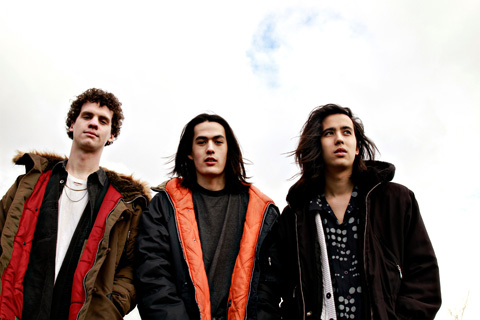
BLONDE AMBITIONS “I used to get really upset when people would describe us as retro or garage rock,” says Smith Westerns vocalist/guitarist Cullen Omori (right, with Max Kakacek and Cameron Cullen). |
Sometimes when we settle into the tattered sofa of lo-fi pop music, it's easy to imagine that the artists intended for it to be made this way. After all, elements such as four-track cassette recorders, cheap microphones, bedroom sound, the natural distortion of old amplifiers, and charming but sloppy first takes do add a certain intimacy and truth that can sometimes be killed in the ultra-professional studio recording process. Other times, though, that sofa they dragged in from the curb is simply the best a fledgling artist could afford on his or her way to greater things.Like other bands with amateurish beginnings before them (such as the Pastels, whose Stephen Pastel insists that his group never wanted to sound amateurish), Chicago's Smith Westerns never intended their 2009 self-titled HoZac Records debut to sound lo-fi. And though their relative inexperience must be taken into consideration (all now barely 21, the trio formed in high school and have been playing since), the Smith Westerns have accomplished more already in terms of making wonderful records than most bands ever will.
Talking on the phone from his first apartment in Chicago, where he and bandmate Cullen Omori live amongst warm beer cans and piles of peanut-butter-covered noodles in the kitchen sink, Smith Westerns' guitarist Max Kakacek insists that his band have intended — and continue to promise — greater things. "We were trying to do all these big epic things," Kakacek says, referring to the band's effort to make their sound grander as they moved past their debut toward their follow-up. "But we were doing them on a weird scale."
Where their buzz-inciting 2009 debut was crummy in all of the best ways, the Smith Westerns' 2011 Fat Possum follow-up Dye It Blonde found the trio — Kakacek and brothers Cullen and Cameron Omori — polishing their sound, but in their own way. The trick was figuring out how to bring in a game-changing producer, Chris Coady (TV on the Radio, Beach House, Cold Cave), while really relying only on their own limited tool kit (twinkling guitars, a sustaining reed organ, piano glissandos, dew-drop harmonies) to create the musical version of a Lego castle — imposing from a distance, but quite child-like up close.
Surprisingly, Dye It Blonde was never intended to be a perfect retro indie-pop statement, but rather a culmination of a late adolescence fueled by musical geekdom and influences that they were being force-fed. The latter included sessions with one older beer-buying friend who the band jokingly called "Daddy" in high school (much to Kakacek's father's chagrin — "My dad wanted to beat him up!").
"I used to get really upset when people would describe us as retro or garage rock," offers lead-vocalist/guitarist Cullen Omori, the Katy Perry–loving populist of the group. "I remember when the Strokes and White Stripes came out and everyone was tagging them as some 'garage-rock revival,' but after a while they became accepted as modern music because that's what it was to begin with."